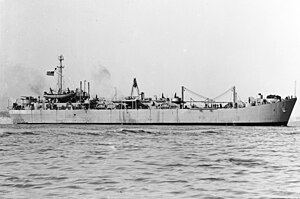This article includes a list of references, related reading, or external links, but its sources remain unclear because it lacks inline citations. (April 2023) |
 USS Egeria (ARL-8) underway near Baltimore, MD., c. April 1944 after completion of conversion. Note the two short kingposts forward widely separated by empty deck space.
| |
| History | |
|---|---|
| Name | USS Egeria |
| Builder | Chicago Bridge & Iron Company, Seneca, Illinois |
| Launched | 23 November 1943 |
| Commissioned | 30 March 1944 |
| Decommissioned | January 1947 |
| Fate | Scrapped, 1980 |
| General characteristics | |
| Class and type | Achelous class repair ship |
| Displacement |
|
| Length | 328 ft (100 m) |
| Beam | 50 ft (15 m) |
| Draft | 11 ft 2 in (3.40 m) |
| Propulsion | 2 × General Motors 12-567 diesel engines, two shafts, twin rudders |
| Speed | 12 knots (14 mph; 22 km/h) |
| Complement | 255 officers and enlisted men |
| Armament | |
USS Egeria (ARL-8) was one of 39 Achelous-class landing craft repair ships built for the United States Navy during World War II. Named for Egeria (a fountain nymph in Roman mythology, and the wife of Numa Pompilius), she was the only U.S. Naval vessel to bear the name.
Originally laid down as LST-136; launched by the Chicago Bridge and Iron Works of Seneca, Illinois 23 November 1943; sponsored by Mrs. Delphine Z. Draut; and placed in reduced commission on 18 December 1943. She proceeded to Baltimore, Maryland, was decommissioned, converted to ARL-8, named Egeria on 3 November 1943 and recommissioned on 30 March 1944.